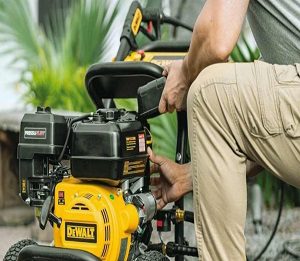
- Chemical Drain Cleaner
- A mechanical drain snake
- Pressure washer
While the most commonly used method in unclogging is the drain snake, it is not the most efficient technique. The drain snake only opens the flow in a relatively small area compared to other methods. This can cause the drain to clog in the short time after the treatment. On the other hand, chemical methods are not recommended for indoor space due to their toxic and harmful smell. The sewer jetter with the pressure washer is the most reliable option in case of frequent clogging and large pipings.
How To Convert A Pressure Washer Into Sewer Jetter
Attachments
You will need specific attachments to convert your pressure washer into the sewer jetter. These things are:
- Ball valve
- Jumper hose
- Hose reel
- Jetter nozzle
These things can be easily purchased from any hardware store or ordered online.
Assembling The Attachments
First, attach the pressure washer hose to the pressure washer as standard settings. Instead of using the spray wand, use the easy to mount ball valve to minimize assembly time. Attach the jumper hose to the other end of the jumper hose. Attach the jumper hose to the hose reel. Now use the appropriate nozzle at the end of the hose reel.
Working
After the installation of the attachments, turn the pressure washer on. Now run the hose reel in the clogged pipe and turn on the ball valve. The water pressure will tend to move the hose further into the tube and would not require much effort to insert it. Run the hose reel in and out of the clogged pipe or drain several times to get the best cleaning effect.
Advantages Of Using Sewer Jetter
The sewer jetter is a less messy and efficient way of cleaning the pipes and drains that are impossible for the conventional chemical or mechanical method. There is a significant risk attached to automated processes because they use the blade that can cause leaks in the pipes. Also, they are ineffective in case of thick clogging and clear a small area that can be easily clogged again.
The chemical method of clearing the clogged pipes is highly discouraged inside the house because it causes harmful smells and fumes that can remain for hours. Moreover, the chemical method can go ineffective when used in large pipes, and it is a one-time usage, and you would have to buy a new chemical for every use. It is not recommended for routine clogs as it can damage the plumbing and pipes. With repeated use, it can cause even more clogs.
On the other hand, a pressure washer does not use any harmful chemical or mechanical blades and can be used in any pipes and drain of any diameter and size. They can be used to clear any clogging from hair to debris and leaves. They clean the lines entirely and are easy to use.
What Type Of Pressure Washer Should Be Used
It is recommended to use the low-pressure washer for the pipes and always use them after a thorough inspection of the lines. Hire a plumber to check the integrity of the pipes if you are using the pressure washer for the first time in the pipes because rusted pipes can burst or leak under high pressure. It is better to hire a professional than to replace all lines and valves and see the mess and damage.
The ideal pressure of the pressure washer in the jetter sewer is 1500 psia, but it can be more than that according to requirements.
Precautions
Although using a pressure washer sewer jetter is safer than the other methods, several precautions must be taken.
- Use only the recommended sewer Jetter kits
- Always wear the complete personal protection equipment (PPE)
- If you are using the pressure washer jetter sewer for the first time, consult the plumber for some advice.
- 10 Best Budget Pressure Washer 2023 – Reviews & Buyer’s Guide - December 7, 2022
- 10 Best Pressure Washer for Cars Wash Reviews [2023] - December 6, 2022
- 10 Best Commercial Pressure Washer 2023 –Buyer’s Guide - December 5, 2022
